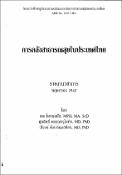บทคัดย่อ
การคลังด้านสุขภาพในประเทศไทย : รายงานด้านวิชาการในอดีตที่ผ่านมา ระบบบริการสุขภาพของประเทศไทยมีการขยายตัวการใช้เทคโนโลยีด้านการแพทย์อย่างรวดเร็ว จนทำให้คนไทยพึ่งการใช้บริการการแพทย์เพิ่มขึ้น ขณะเดียวกันพฤติกรรมการดูแลสุขภาพด้วยตนเองถูกละเลยเพิ่มขึ้น ค่าใช้จ่ายด้านสุขภาพทั้งในภาครัฐและเอกชนเพิ่มขึ้นกว่า 75% สัดส่วนที่สูงที่สุดมาจากกระทรวงสาธารณสุข เทียบกับภาคเอกชน 25% ระหว่างปี พ.ศ. 2529 – 2539 งบประมาณกระทรวงสาธารณสุขเพิ่มขึ้นกว่า 258% และมีอัตราการเติบโตลดลงตั้งแต่ปี พ.ศ. 2540 เนื่องจากข้อจำกัดด้านงบประมาณจากภาวะวิกฤติเศรษฐกิจ จากนั้นระหว่างปี พ.ศ. 2538 – 2542 งบประมาณมีอัตราเพิ่มขึ้น 6% เมื่อพิจารณาเฉพาะงบประมาณในปี 2541 มีการจัดสรรดังนี้ 42% เป็นหมวดเงินเดือน 31% เป็นค่าใช้จ่ายหมุนเวียน เช่น เวชภัณฑ์ และ 27% เป็นหมวดการลงทุน งบประมาณมีการจัดสรรตามค่าใช้จ่ายที่เกิดขึ้นในอดีต ซึ่งไม่ทำให้เกิดความเป็นธรรมในการจัดสรรระหว่างจังหวัดด้วยกัน ค่าใช้จ่ายด้านสุขภาพจากกระเป๋าผู้ป่วยโดยตรงเป็นสัดส่วนที่สำคัญที่เป็นรายได้ของสถานบริการของรัฐเพื่อเป็นเงินสนับสนุนการดำเนินการสถานบริการ ขณะที่ระบบบัญชีของสถานบริการของรัฐยังไม่มีประสิทธิผล ทำให้งบประมาณที่รัฐบาลจัดสรรให้กับสถานบริการแต่ละแห่งไม่ทราบแน่ชัดว่าครอบคลุมค่าใช้จ่ายจริงหรือไม่ และไม่สามารถกำหนดอัตราการจ่ายตามหัวเมื่อปรับตามอายุ เพศ หรือการคิดค่า DRGsได้ถูกต้องประเทศไทยมีโครงการประกันสุขภาพ 5 โครงการหลักด้วยกัน ได้แก่ สวัสดิการข้าราชการ ประกันสังคม บัตรสุขภาพ สวัสดิการรักษาพยาบาลแก่ผู้ที่ควรได้รับการช่วยเหลือจากสังคม และประกันสุขภาพเอกชน ประมาณ 76% ของประชากรทั้งหมดมีประกันสุขภาพอย่างหนึ่งอย่างใด สำหรับสวัสดิการข้าราชการเป็นการคุ้มครองข้าราชการ ผู้ที่เกษียณราชการ และสมาชิกครอบครัว กองทุนนี้สนับสนุนจากภาษีรัฐ และควบคุมจัดการโดยกระทรวงการคลัง ซึ่งตั้งแต่เกิดวิกฤติเศรษฐกิจ ได้มีการควบคุมค่าใช้จ่าย โดยการกำจัดสิทธิ์การรักษาจากสถานบริการเอกชน และร่วมจ่ายในกรณีบางงานบริการ หรือ หากต้องการได้รับยานอกบัญชียาหลักต้องร่วมจ่ายบางส่วน กรณีประกันสังคม เป็นระบบการจ่ายเบี้ยประกันได้จากการหักเงินเดือนลูกจ้าง 1.5% ของเงินเดือน และในปริมาณเท่ากันจากนายจ้าง และกระทรวงสวัสดิการและแรงงาน ระบบการจ่ายเป็นการทำสัญญากับโรงพยาบาลทั้งของรัฐและเอกชน และเป็นการจ่ายตามหัวอยู่ระหว่าง 700-1000 บาทต่อคนต่อปีโครงการบัตรสุขภาพเป็นกองทุนชุมชน กลุ่มเป้าหมายได้แก่กลุ่มเกือบจน ผู้ประกันตนต้องจ่าย 500 บาท และได้รับสมทบเพิ่มเติมอีก 1000 บาท (500 บาทจากกระทรวงสาธารณสุข และ 500 บาทจากธนาคารเพื่อการพัฒนาเอเชีย) ปัญหาหลักที่สำคัญของโครงการนี้ คือ ไม่สามารถครอบคลุมกลุ่มเป้าหมายได้ดีนัก ส่วนใหญ่ผู้ถือบัตรเป็นกลุ่มรวย ส่วนประชากรที่เกือบจนอีกจำนวนมากยังไม่ได้รับการคุ้มครอง โครงการสวัสดิการประชาชานเดิมครอบคลุมกลุ่มจน ต่อมาขยายการคุ้มครองไปยังกลุ่มเด็กแรกเกิดจนถึง 12 ปี กลุ่มทหารผ่านศึก ผู้นำศาสนาและผู้นำชุมชน และผู้พิการ โครงการนี้ยังไม่สามารครอบคลุมประชากรตามกลุ่มเป้าหมายได้ทั้งหมด ผู้ประกันตนส่วนใหญ่มักข้ามไปรับบริการจากสถานบริการระดับสูงมากกว่าสถานบริการเบื้องต้นที่ตนลงทะเบียนไว้ เช่น สถานีอนามัย รายงานนี้เสนอว่าควรมีการพัฒนาให้เกิดหลักประกันสุขภาพถ้วนหน้า
บทคัดย่อ
Health financing in Thailand : Technical reportFor the past, Thailand’s health care system has increasingly emphasised more advanced medical technologies and the Thai have been more reliant upon health care providers than self-care. Both public and private expenditures for health services consequently increased in real terms. 75% of health expenditures (the largest portion, 66% from the Ministry of Public Health (MOPH)) was incurred in the public sector compared with 25% in the private. During 1986 to 1996, the MOPH budget increased by 258% in real terms and then dropped since 1997 because of budget constraint caused by economic crisis. From 1995 to 1999, the budget grew about 6% in real terms. In consideration of the MOPH budget in 1998, 42%, 31% and 27% were gone for salaries, recurrent inputs and capital expenditures respectively. The budgeting was based on historical requirement leading to inequity of financing among provinces. Household expenditure became a portion of revenue to public health facilities. Whether the government budget for each public health facility was sufficient remained dubious due to poor cost accounting of public health facilities. Therefore, determining either capitation rates weighted by age, sex or DRGs was inconclusive.Thailand had 5 major health insurance schemes, Civil Servants’ Medical Benefits Scheme (SCMBS), Social Security Scheme (SSS), Voluntary Health Card Scheme (VCS), Low-income Card Scheme (LICS) and Private Indemnity Insurance. Around 76% of the Thai were covered by one of these. The CSMBS covered all government employees, pensioners and their dependents. The program was financed by government tax and managed by the Ministry of Finance. Since the economic crisis, the program did cost control by abolishing reimbursement for private care and imposing co-payment for some services e.g. for non-essential drugs. The SSS was premium-based by collecting 1.5% from the employee, the employer and the Ministry of Social Welfare. Payment to contracted hospitals was on capitation from 700-1000 Baht per head per year.The VHCS was community revolving funds targeting the near poor. The premium was 500 Baht supplementary to 1000 Baht, 500 Baht from the MOPH and 500 Baht from the ADB. The most problem of the program was ineffective targeting measure. The wealthy got the cards while a large number of the near poor were not covered. The LICS basically intended to cover the poor but its objective was enlarged to cover the elderly, children under 12, veterans, religious and community leaders and the handicapped. The program also had a problem of targeting the deserved. On the demand side, the insured often bypassed to their registered hospitals preferable to registered primary care centres or health centres. The paper recommends development of universal health coverage for all.


